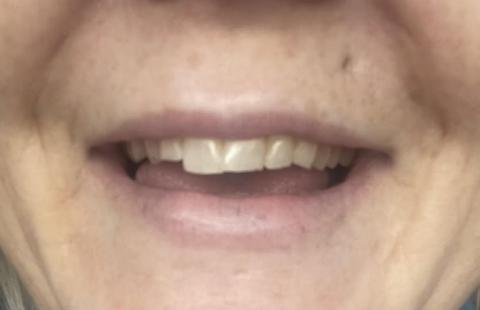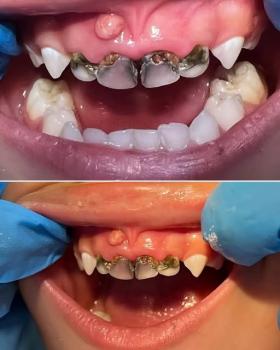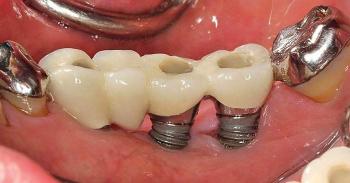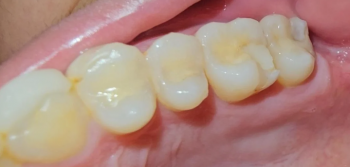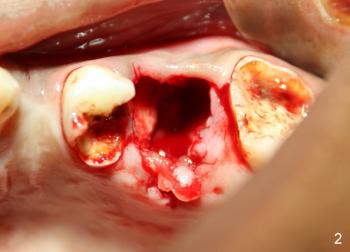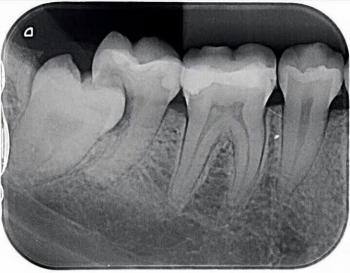Strong Teeth, Fresh Breath, Brighter You.
Fixing Worn and Crooked Teeth at 50: Affordable Smile Makeover for Adults Who Grind Their Teeth
Severity:
Teeth Problems:
Quick visual findings (from the photo)
-
Incisal wear / flattened edges on the upper front teeth — classic for bruxism (tooth grinding).
-
Uneven incisal edges and small chips on the front teeth.
-
Color is mildly yellowed (surface staining/enamel tone).
-
Gums and surrounding tissue look okay in the photo (no obvious inflammation), but a full exam is needed to confirm periodontal health.
-
Overall: teeth are structurally intact (you said no cavities) but show wear and esthetic irregularities that are very treatable.
Probable diagnosis
-
Bruxism-related tooth wear (current or historic).
-
Minor enamel chipping & uneven incisal levels.
-
Mild discoloration / staining.
Nothing in the photo looks like urgent disease (infection or large cavities), but this is NOT a substitute for an in-person exam and x-rays.
Immediate actions you can take (days → weeks)
-
Get a custom night guard (occlusal splint) — highest priority. Protects teeth from further wear and prevents new chips. Many dental plans cover part of this cost.
-
Avoid hard foods (nuts, ice, hard candy) and habits like chewing pens.
-
Maintain anxiety care (your meds + relaxation) — lowering clenching will help healing and outcomes.
-
Book a dental exam with x-rays to confirm no hidden problems and to get dental records/photos for planning.
Timeframe: a night guard can usually be made in 1–2 dental visits over 1–3 weeks.
Cosmetic & functional treatment options (ordered by invasiveness & cost)
You can combine these; most people do treatment in phases.
-
Dental bonding (composite) — reshape and lengthen worn edges, repair small chips, improve symmetry.
-
Visits: usually 1–2 visits.
-
Recovery: immediate function; mild sensitivity possible a few days.
-
Cost: relatively affordable per tooth.
-
-
Whitening (bleaching) — improves overall color before any bonding/veneers so restorations match.
-
Visits/options: professional in-office or take-home; 1–2 weeks for take-home, one session for in-office.
-
Minimal recovery.
-
-
Orthodontics (straightening):
-
Clear aligners or braces to straighten teeth and correct bite (can also reduce wear long-term).
-
Timeframe: 6–24 months depending on how much movement you need; limited/front-only treatments can be 3–9 months.
-
Cost: varies; check insurance coverage for adult ortho.
-
-
Veneers or porcelain restorations — for more uniform shape/length and color (more durable and esthetic than bonding but more expensive and irreversible).
-
Timeframe: 2–6 weeks from consult to completion.
-
Recovery: few days to adapt.
-
-
Crowns — only if a tooth is severely worn or fractured; more invasive.
Recommended typical sequence: Protect (night guard) → Straighten (if desired) → Whitening → Conservative bonding or veneers for final shape. Doing orthodontics before veneers/bonding gives more conservative tooth preparation.
“Timeframe to heal” & what to expect
-
If you mean recovery after minor cosmetic work (bonding/whitening): hours to a few days (some sensitivity).
-
For orthodontics: active movement months to years, but daily life is normal during treatment.
-
For a night guard: you’re protected immediately once you start wearing it.
If you mean “if it takes 14 days” — most dental cosmetic procedures don’t require a 14-day healing period except for surgical work (extractions, implants). Short procedures will not “heal into” a final result in 14 days; they’re immediate or take weeks for lab work.
Risks / what can scale up if you delay treatment
-
Continued grinding → more enamel loss, larger chips, tooth sensitivity, possible need for more invasive restorations (crowns) later.
-
Uneven wear can change your bite and cause TMJ/jaw pain or headaches.
-
If discoloration or chips bother your confidence, emotional impact continues.
Delaying won’t usually cause infection if you have no cavities, but it may increase cost and invasiveness later.
Practical next steps — what you can do this week
-
Call your dentist and ask for:
-
a full exam and bite evaluation,
-
a custom night guard quote and whether insurance covers it,
-
an estimate for bonding/veneers and orthodontic consult.
-
-
Schedule an orthodontic consult (some offer free/low-cost consults).
-
Use the directory you mentioned (https://cebudentalimplants.com/map-dental-clinic) to find clinics near you and compare fees / financing.
-
Ask about payment plans and whether your plan has an orthodontic lifetime maximum (if applicable).
Questions to bring to your dentist / orthodontist
-
Do I need x-rays or study models now?
-
Can you evaluate my bite and bruxism? Can you make a night guard? Is it covered by my insurance?
-
For straightening: how long will treatment take for front-teeth alignment only? Are clear aligners an option? Cost estimate?
-
For esthetics: would bonding or veneers be better for my goals and budget?
-
If I delay treatment a year, what are likely changes to expect?
Cost & insurance tips
-
Night guards are often partially covered. Ask your insurer for a prior-authorization.
-
Dental schools can be much cheaper (supervised students).
-
Use in-house financing or split treatment into phases to spread costs across years.
-
Use your annual maximum wisely (start the high-priority items in year 1, cosmetic finishing in year 2 if needed).
Final checklist you can print / show your dentist
-
Night guard: yes
-
Full exam + x-rays: yes
-
Orthodontic consult: yes
-
Whitening before bonding/veneers: yes
-
Conservative bonding for chipped/worn edges: yes

